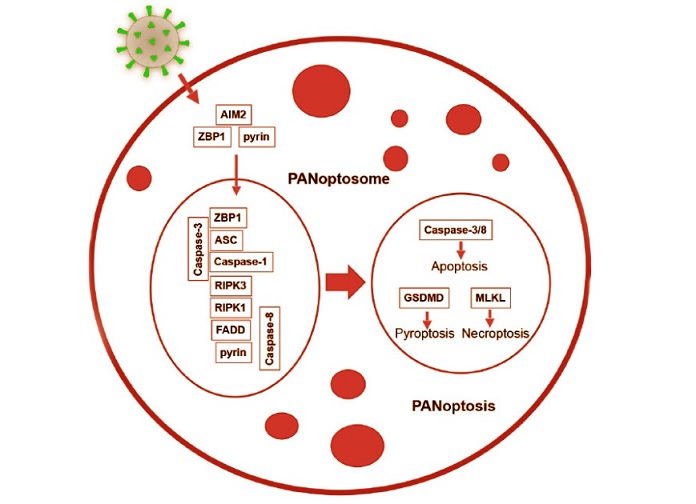Many Are Unaware That COVID-19 Induced PANoptosis is Slowly Killing Them Despite Having Only Mild Infections!
Nikhil Prasad Fact checked by:Thailand Medical News Team May 04, 2025 6 months, 5 days, 22 hours, 58 minutes ago
Medical News: As the world continues to grapple with the aftermath of the COVID-19 pandemic, emerging research has unveiled a concerning mechanism by which the virus may be causing severe damage to the human body. This exclusive
Medical News report highlights the role of PANoptosis, a unique form of inflammatory cell death, that can kill many slowly and is not even detectable or symptomatic in the initial stages. This discovery sheds light on how SARS-CoV-2, the virus responsible for COVID-19, can trigger a cascade of cellular events leading to multi-organ failure and, in some cases, early death.
 Many Are Unaware That COVID-19 Induced PANoptosis is Slowly Killing Them Despite Having Only Mild Infections!
Understanding PANoptosis: A Convergence of Death Pathways
Many Are Unaware That COVID-19 Induced PANoptosis is Slowly Killing Them Despite Having Only Mild Infections!
Understanding PANoptosis: A Convergence of Death Pathways
PANoptosis is a newly identified form of programmed cell death that integrates elements from three distinct pathways: pyroptosis, apoptosis, and necroptosis. Unlike traditional cell death mechanisms, PANoptosis is characterized by its highly inflammatory nature, leading to extensive tissue damage. The process is orchestrated by a multi-protein complex known as the PANoptosome, which includes key molecules such as ZBP1, RIPK1, RIPK3, and caspase-8. These components work in concert to execute the cell death program, resulting in the release of pro-inflammatory cytokines and further amplifying the immune response.
A person with a mild COVID-19 infection could experience PANoptosis (a form of programmed cell death) and not realize it. PANoptosis is a complex cellular process and its presence doesn't always lead to noticeable symptoms, especially in milder cases of the virus. The effects of PANoptosis depend on the location and extent of cell death, which might not always be visible.
It was previously assumed that PANoptosis only manifest during severe COVID-19 infections but recent studies have shown that even mild infections can trigger PANoptosis which does not give out any tell-tale signs till severe organ or tissue damage occurs!
SARS-CoV-2: The Catalyst for PANoptosis
Recent studies have demonstrated that SARS-CoV-2 can activate PANoptosis through several mechanisms. The virus induces the formation of Z-RNA within infected cells, which is then recognized by the innate immune sensor ZBP1. This recognition leads to the assembly of the PANoptosome complex and the initiation of the inflammatory cell death process. Additionally, elevated levels of cytokines such as TNF-α and IFN-γ, commonly observed in severe COVID-19 cases, have been shown to synergistically trigger PANoptosis, further contributing to tissue damage and disease progression.
Clinical Implications: From Lung Damage to Multi-Organ Failure
The activation of PANoptosis in COVID-19 patients has significant clinical implications. The inflammatory nature of this cell death pathway leads to widespread tissue damage, particularly in the lungs, resulting in acute respiratory distress syndrome (ARDS). Moreover, the systemic inflammation ca
n extend to other organs, causing multi-organ failure. The correlation between PANoptosis and disease severity underscores the importance of understanding this pathway to develop targeted therapeutic interventions.
Therapeutic Targets: Inhibiting the PANoptosome
Given the detrimental effects of PANoptosis in COVID-19, researchers are exploring potential therapeutic strategies to inhibit this pathway. Targeting key components of the PANoptosome, such as ZBP1 or RIPK3, may offer a means to mitigate the inflammatory cell death process. Additionally, modulating the levels of pro-inflammatory cytokines like TNF-α and IFN-γ could help in controlling the excessive immune response associated with PANoptosis. These approaches hold promise in reducing the severity of COVID-19 and improving patient outcomes.
Conclusion: Unveiling the Silent Saboteur
The discovery of PANoptosis as a critical factor in the pathogenesis of COVID-19 provides valuable insights into the mechanisms driving severe disease outcomes. By understanding how SARS-CoV-2 hijacks cellular death pathways to induce widespread inflammation and tissue damage, researchers and clinicians can develop targeted therapies to counteract these effects. As the scientific community continues to unravel the complexities of COVID-19, addressing the role of PANoptosis will be essential in mitigating the long-term impacts of the pandemic.
References:
https://www.science.org/doi/10.1126/sciimmunol.abo6294
https://www.nature.com/articles/s41422-022-00775-y
https://academic.oup.com/bib/article/25/3/bbae124/7636766
https://www.cell.com/cell/fulltext/S0092-8674(20)31542-7
https://www.frontiersin.org/journals/immunology/articles/10.3389/fimmu.2023.1148727/full
https://www.authorea.com/users/861122/articles/1253438-panoptosis-as-a-therapeutic-target-for-covid-19
https://www.sciencedirect.com/science/article/pii/S1286457923000825
https://www.mdpi.com/1420-3049/26/24/7459
https://www.sciencedirect.com/science/article/pii/S0022283621004824
https://www.frontiersin.org/journals/immunology/articles/10.3389/fimmu.2023.1120034/full
For the latest COVID-19 News, keep on logging to Thailand
Medical News.
Read Also:
https://www.thailandmedical.news/news/covid-19-breakthrough-panoptosis-discovered-to-be-main-cause-for-inflammation-in-covid-19--tnf-alpha-and-ifn-gamma-blockers-can-help-treat-covid-19
https://www.thailandmedical.news/news/the-deadly-connection-of-covid-19-and-raas-overactivation
https://www.thailandmedical.news/news/covid-19-research-university-of-illinois-study-shows-that-nonstructural-proteins-of-sars-cov-2-dysre
https://www.thailandmedical.news/pages/thailand_doctors_listings
https://www.thailandmedical.news/articles/hospital-news
